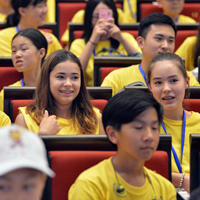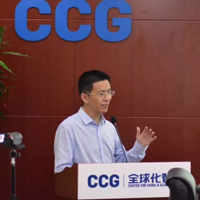- 当前位置:
- 首页>
- 活动>
- ������������
������������
CCG持续关注国际关系议题,推动中国与全球化的发展,积极开展国际交流,充分发挥智库“二轨外交”作用,在巴黎和平论坛、达沃斯世界经济论坛、慕尼黑安全会议等重要国际政策与意见交流平台上组织分论坛、边会、圆桌会议、晚宴等活动,促进国际政商学界对话,凝聚共识;CCG积极与各国政界、智库界、工商界开展“二轨外交”活动,每年常态化赴多国调研与交流,促进中外关系攸关方互动,保持与多国政策圈层的沟通渠道。
-

【Global Times】Chinese tourists reluctant to visit US amid trade spat
Travelers turn to Europe, Russia insteadTourists in Guangzhou, capital of South China’s Guangdong Province, book trips to the US in 2016. File photo: ICChinese tourists’ interest in traveling to the US has withered as peak vacation season approaches amid escalating trade tensions between the two countries, industry data and analysts suggested on Wednesday. And domestic tourists might turn to Europe and Russia instead, which analysts said could hurt the US hospitality, catering and other tourism-related industries.Data provided by online travel platform Mafengwo.com to the Global Times on Wednesday showed that in the first half of 2018, search popularity for once popular US cities, including Los Angeles, New York, San Francisco, Las Vegas and Boston, showed a decline in July, traditionally a peak season for US tourism.Meanwhile, Chinese tourists showed increasing interest in cities in Russia and some European countries. For example, Moscow was up 78 percent in popularity, while Nice in France was up by 31 percent, Mafengwo data showed.Jiang Yiyi, director of international tourism development at the Beijing-based China Tourism Academy, told the Global Times on Wednesday that though the number of Chinese tourists is not the highest among foreign tourists in the US, "our purchasing power definitely ranks among the top of the list."According to a report from the US Travel Association, China was the third-largest overseas inbound travel market to the US in 2016. US travel exports to China (spending by Chinese visitors and students in the US, and on US airlines) reached $33.2 billion in 2016, significantly higher than any other country. Average spending per Chinese visitor was $6,900 in 2016, the highest of all international visitors. "If the number of Chinese tourists decreases, entire tourism-related services sectors in the US are set to be harmed, including shopping destinations, airlines and the catering industry," Jiang said.In the beginning of the month, Brand USA, an organization under the Travel and Tourism Act to promote the US globally, led a group of eight tourism-related US entities to Harbin, capital of Northeast China’s Heilongjiang Province in a bid to attract more tourists.The US Travel Association report also said that China is projected to be the US’ second-largest overseas inbound market by 2020.However, experts noted that under the current Sino-US trade relations, the goal might not be achievable."Chinese people’s sentiment toward the US will surely be affected by the US policy on China, and to find an alternative country for travel is ’effortless’ for tourists," Jiang noted."Chinese people will ’vote with their feet’ like they did last year during South Korea’s Terminal High Altitude Area Defense system issue."A 40-something mother in Nanjing, capital of East China’s Jiangsu Province told the Global Times that she was planning to take her son, who has just finished the college entrance examination, to the US for this summer vacation, but she has changed her mind due to the unstable situation."I hoped that my son could experience the local culture in an English-speaking country like the US, but due to the Sino-US trade spat, and concerns over the gunshots and robberies in the US, we decided to go to Europe instead," she said."Declining interest in the US as a tourist attraction is the choice of the Chinese people, which is not forced by the government, showing that the country, from the government to its people, is quite concerned and cautious about the prospects of the US," He Weiwen, senior fellow at the Center for China and Globalization(CCG), told the Global Times on Wednesday.Given the current situation, it is highly possible China will target other US service trade sectors. For example, China might choose not to open its banking and insurance sectors to US enterprises when opening up further to other countries, He noted.From Global Times,2018-7-11
2018年7月16日 -

【Global Times】Summer camps for Chinese youth help promote CPC’s image abroad
Pictured is young participants at the Chinese Root-Seeking Tour Summer Camp in Qianshan county, East China’s Jiangxi Province in August 2017. About 900 overseas Chinese students participated in the event. Photo: ICSummer camps for overseas Chinese youth organized by the overseas Chinese affairs authorities have recently kicked off in many provinces, with tens of thousands of participants learning Chinese traditional culture and history for around two weeks. Chinese analysts believe that the summer camps satisfy the need of overseas Chinese to discover and learn about their ancestors and ancestral homes, and enhance a common sense of Chinese tradition and culture. More importantly, the camps may further boost overseas Chinese’s understanding of China as well as the Communist Party of China (CPC), which may help promote the image of the Party abroad, analysts noted. There were about 50 million overseas Chinese as of 2014, according to a report issued by Center for China and Globalization (CCG).Find Your RootsThe Chinese Root-Seeking Tour Summer Camp, organized by the Overseas Chinese Affairs Office of the State Council, debuted in 1999 with the purpose of improving overseas Chinese youth’s understanding of their ancestral homes, and boosting their interest in learning Chinese language and culture, according to the official WeChat account of the camp. There are also spring, autumn and winter camps for overseas Chinese students, which usually last for two to three weeks. Overseas Chinese students can learn basic knowledge about Chinese history, geography, culture, martial arts and folk dances, visit scenic spots and communicate with Chinese students. An employee from the Quanzhou Overseas Chinese Affairs Office in East China’s Fujian Province surnamed Xu told the Global Times that the office will organize a summer camp for 40 participants in August. Their previous camps took overseas Chinese youth to learn about local Fujian and classical Chinese traditional culture including martial arts."We were fully booked in our previous camps," Xu said. Huang Fengqiong, leader of a Chinese Root-Seeking Tour Summer Camp in Luojiang district of Quanzhou, Fujian Province, told the news site chinanews.com that her members love the courses in the camp, and they could feel the Chinese mainland’s development in various fields. The camp Huang is attending has a total of 58 members from the US and Taiwan. The 10-day summer camp started from Monday, and teaches the Chinese traditions of martial arts and dragon dancing. The campers will also go sightseeing to local traditional buildings. Similar summer camps were also recently kicked off in Northwest China’s Qinghai Province, East China’s Zhejiang and Jiangsu provinces. Joining handsExperts believe that such camps can also serve as part of the CPC’s united front work to unite overseas Chinese. News of various cultural exchanges featuring summer camps attended by overseas Chinese can be found on the website of the United Front Work Department of the CPC Central Committee. The department has listed 12 types of groups as part of its united front work, including overseas Chinese and people from Taiwan, Hong Kong and Macao, according to a work regulation released by the department in 2015, the Xinhua News Agency reported."Such activities, if carried out effectively, could enhance overseas Chinese youth’s understanding and acknowledgment of the CPC, and promote a positive image of the CPC abroad," Zhi Zhenfeng, associate research fellow at the Institute of Law with the Chinese Academy of Social Sciences, told the Global Times. Su Wei, a professor at the Communist Party of China Chongqing Committee’s Party School, told the Global Times that such camps satisfied a spiritual longing of overseas Chinese who have the desire to find their ancestors, and it’s possible that they could later become supporters of China’s political system after viewing China’s rapid development. "It’s also worth noting that China would not use these activities to affect the political system of other countries, as some countries speculated," Su said. China’s united front work among overseas Chinese is conducted in line with international conventions, and China has been adhering to the principles of openness, following the law and reciprocal benefits, Zhang Yijiong, executive vice-minister of The United Front Work Department of the CPC Central Committee, said on the sidelines of the 19th CPC National Congress in 2017, according to chinanews.com. From Global Times,2018-7-11
2018年7月16日 -

【BJ Review】Wang Huiyao: Firm in Globalization
Salespersons promote the use of Chinese mobile payment service Alipay in a supermarket in Frankfurt, Germany, on December 11, 2017 (XINHUA) Under the banner of "America First," U.S. President Donald Trump has launched a trade war against his country’s main trading partners, with China the major target. Notably, besides China, most of the countries under fire are long-term political and military allies of the United States. Few anticipated the antagonism of the Trump administration in initiating such trade friction worldwide. Unilateralism and protectionism from the United States—the world’s largest economy—will likely further hinder the already slow recovery of the global economy. It is so far unclear which side, if any, can win this global trade war, but one outcome is certain: The world economy will be the major victim of escalating tariffs.Effective since July 6, the United States and China have imposed 25-percent tariffs on $34 billion of each other’s imported goods. If the two sides eventually introduce tariffs on $250 billion of imports each, as threatened, then the world economic growth is expected to fall 0.5 percentage points between 2019 and 2020. The potential consequences are better illustrated by the stake each country holds in the global economy. Global GDP was $81 trillion in 2017, of which the United States contributed $19.39 trillion—a share of 23.9 percent—while China accounted for $12.25 trillion or 15.12 percent. The economies of China and the United States together constituted nearly 40 percent of the world’s GDP and made up more than 40 percent of global economic growth. According to statistics from the World Bank, the global economy increased 3 percent in 2017, and China alone contributed 34 percent of the total.Trade disputes are certain to give rise to more uncertainties in the world. Heavy tariffs will inevitably raise the cost of goods, resulting in a negative impact on investment, production and consumption. The ensuing drop in investment, downsizing of enterprises and unemployment of workers will in turn affect consumption, leading to a vicious cycle.The headquarters of the Asian Infrastructure Investment Bank in Beijing (XINHUA) Deliberate errors As the initiator of this trade war, policymakers in the United States believe that their success is assured. Based on a few simple calculations, Trump seems to have drawn the conclusion that his attempts to intimidate China can help achieve the goal of restricting imports from China and balancing the China-U.S. trade deficit. But in an era of globalization, national economies are intertwined in a system of cooperation and labor division, and such a strategy cannot succeed.Several misjudgments have been made by the United States in formulating the justification for its trade war, and closer analysis suggests there are inaccuracies in statistics used. Last year, of the $530 billion trade between China and the United States, more than $100 billion was actually transited from Hong Kong, Macao and places other than the Chinese mainland, which was not included in U.S. exports to China. Moreover, the volume of trade in services between China and the United States reached $118.2 billion in 2017, of which services purchased by China from the United States reached $90 billion. Yet this number was excluded from the calculated trade volume between the two countries, thus the United States’ $54.7 billion service trade surplus has been deliberately ignored.Another major error is the underestimation of the Chinese market. After 40 years of reform and opening up, China, with a population of around 1.4 billion, is not only the factory of the world, but also a substantial international market. Without China’s manufacturing capacity and market demand, a lot of high-end U.S. technology companies would struggle to maintain their current rate of profit, hindering their operation and innovation. U.S. chipmaker Qualcomm is a good case in point. Experts have pointed out that the global market value of the chip industry was $440 billion in 2017, of which China accounted for $260 billion, with around 70 percent of high-end chips manufactured by the United States sold to China. Without the Chinese market, the United States would struggle to find another place to sell 70 percent of its chips. The research and development of the U.S. chip industry would instead be badly affected and lose its dominance in the global market, with leading companies like Qualcomm set to bear the brunt.Moreover, for many U.S. multinationals, the Chinese market sits atop their list of global business priorities. In 2017, China became the world’s largest market for General Motors with a sales value of $42 billion, surpassing the company’s domestic market. Apple’s sales reached $46 billion in China last year, second only to the U.S. market.The United Sates has not taken all these factors into account when initiating this trade war, but has instead chosen to use simple and crude logic to fantasize about victory over its opponents.Opportunity for reform China also cannot escape from the trade spat unscathed. The increase of tariffs will certainly impact China’s exports, affecting the business of a large number of export-oriented enterprises and causing a corresponding rise in unemployment. However, after decades of rapid development, China has accumulated plenty of experience in addressing external challenges, which is the basis for a mature crisis-management system. In addition, China’s huge population provides the country with the unique advantage of an expanding domestic market which can help effectively shift the growth driver from exports to consumption and promote consumption upgrading.In the meantime, China must seize the opportunity to further expand opening up and accelerate domestic reform. The case of ZTE, the Chinese telecommunications equipment maker that was forced out of business by a U.S. export ban, has allowed China to fully understand the gravity of its technology gap with developed countries and has also shown the direction in which the country’s industry must develop. Integrating its resources to concentrate on technological breakthroughs should be the key requirement of China’s supply-side structural reform.International free trade will inevitably be affected by a global trade war. After a series of unexpected events targeting globalization in the past two years, the world is facing new challenges. China, as a beneficiary from globalization and free trade in the past several decades, should stand firm and unite with the international community in order to safeguard globalization and to prevent the world from becoming mired in the downward spiral of anti-globalization.Faced with challenges from the United States, joining the Comprehensive Progressive Trans-Pacific Partnership (CPTPP) and helping to reshape the rules of global trade are other important steps that China must take. Following the United States’ withdrawal from the Trans-Pacific Partnership after Trump took office, the 11 other countries in the trade agreement reached the CPTPP. The agreement, led by countries such as Japan, Australia, New Zealand and Chile, maintains a more liberal approach to global trade, even more so than the World Trade Organization (WTO). In joining the CPTPP, China can overcome U.S. attempts to isolate it.While the WTO is stagnating, the CPTPP lays more emphasis on the protection of intellectual property rights and liberalization of trade in services. In 2017, the service industry contributed 51.6 percent to China’s GDP and 58.8 percent to China’s economic growth. The CPTPP will give a new boost to the development of the service industry in China.Perhaps most importantly, joining the CPTPP conforms to the principles of safeguarding globalization and promoting trade liberalization and facilitation. It can also help contain the current trends of protectionism and isolationism, manifesting China’s resolve for further opening up.There is no winner in a trade war, just as there is no loser in globalization, with every country able to benefit from the process. Over the past 40 years, global trade has been a major force in promoting globalization and globalization has in turn served as an important driver of global growth. It is thus clear that the current protectionism of the United States harms others without benefiting itself.From BJreview,2018-7-19
2018年7月16日 -

【人民网】方太茅忠群:中国企业应发扬自己的管理智慧
人民网北京 7 月 13 日电 ( 记者夏晓伦 ) " 中国企业不能一直照搬西方经验 , 在全球化进程中 , 应该有自己的管理智慧。" 近日 , 在中国与全球化智库举办的企业管理论坛上 , 中国与全球化智库理事、方太董事长茅忠群提出 , 以仁爱、良知为核心的儒家管理 , 已成为中国企业向世界贡献的管理智慧 , 也是中企在全球化角逐中取得市场地位的压舱石。全球化智库(CCG)资深副主席、方太董事长茅忠群。 ( 人民网记者 夏晓伦摄 ) 今年是改革开放 40 年 , 又逢 " 一带一路 " 中企走出去的关键之年。数据显示 , 自 2010 年开始 , 我国经济总量第一次超过日本 , 成为世界第二大经济体。同时 , 在 " 财富世界 500 强 " 榜单中 , 中国上榜公司数量连续增加 ,2017 年达到了 115 家。中国企业如何进一步助力新时代经济社会可持续和高质量发展 , 如何在全球化进程中获得更大空间、树立中企管理自信 , 成为当前中国企业家关注的焦点。 " 中国企业、中国管理应该有自己的哲学 , 实践与探索中国管理模式是企业家的历史责任。而当前已经到了系统梳理中国企业管理理论的关键时候了。" 作为儒道管理模式的开创者 , 中国与全球化智库理事、方太董事长茅忠群认为 , 过去学习的西方管理 , 尽管很多流程、体系、制度、工具、方法等都被实践证明是很好的 , 但西方管理只解决了企业管理与发展之 " 术 ", 而中华优秀的传统文化更应该成为中国企业管理的 " 道 "。 据了解 , 茅忠群从 2008 年开始在方太导入儒家文化 , 并逐步形成了把儒家文化和西方管理相结合的具有中国特色的管理模式 , 并且以此管理让方太在去年成为中国首个超百亿的家电企业。 在中国与全球化智库企业管理论坛上 , 茅忠群表示 , 在儒道管理模式中 , 除 " 中学明道、西学优术、中西合璧、以道御术 " 外 , 还包括 " 其身正不令而行 , 其身不正虽令不从 " 企业管理者的品德领导、道德教化与礼制规范相结合的德礼管理、" 修己以安人 " 的仁道经营 , 以及不断自省的领导人修炼。文章选自人民网,2018年7月13日
2018年7月16日 -
郑永年十论中美贸易战 | 合辑
郑永年,CCG学术专家委员会主任、新加坡国立大学东亚研究所所长编者按随着中美贸易战的正式开打,越来越多的中国民众希望全面得到贸易战的权威解读和前景分析。郑永年教授已经撰写了大量有关贸易战的深度分析文章。然而网络上一些别有用心之人精心伪造并大肆传播郑永年教授点评中美贸易战的图文。这些观点以移花接木的方式,恶毒歪曲了郑永年教授的观点。为了更好地全面展示郑永年教授对于贸易战的分析,IPP评论特别精选了郑永年教授自今年2月份以来的十篇文章,分享给各位读者。点击下面的文章即可阅读。郑永年:中国能打赢贸易战吗?郑永年:贸易战与特朗普的国际新秩序郑永年:特朗普正在改变美国长期以来的对华政策郑永年:贸易战即便爆发,中国的天也不会塌郑永年:贸易战打响,中美新冷战真的要来了郑永年:2018年的新一波“中国威胁论”来势更猛郑永年:特朗普贸易战瞄准的是“中国制造2025”郑永年:全球化时代的贸易战如何“以牙还牙”?郑永年:技术冷战与中美冷战的序曲郑永年:中美科技民族主义之间的冲突文章选自IPP评论,2018年7月13日
2018年7月16日 -
茅忠群:“中西合璧,以道御术”的儒道管理
理事简介茅忠群,CCG资深副主席,方太集团董事长。在中国,很多人都认同的一个道理,一个企业的文化本质上就是这家企业的老板文化,这个观点放到方太这家企业非常适用。方太集团董事长茅忠群从10年前就在方太推行儒道文化,并且把很多儒家思想运用到企业的管理当中。践行10年之后,这家企业的气质确实发生了变化,企业的员工通过多年学习,耳濡目染,形成习惯,深深地被儒道文化所改变。而茅忠群自己更像是一个“士大夫”,语速缓慢低沉,低调斯文中透着浓厚的书生气,可以随口引经据典,儒家思想脱口而出,据说茅忠群在公司里从来没有对谁发过脾气。然而,就是这样一位看似温和、内敛、没脾气的老板,却带领方太成为厨电行业第一家营收超过100亿元的企业。无论是方太创新的产品,还是其独特的企业文化,在国内的厨电行业都是独树一帜。方太如何运用儒道文化带动企业创新和员工的成长?儒家文化又是如何贯彻到企业中每一个员工的心中?具体如何执行?日前,《中国经营报》记者专访了方太董事长兼总裁茅忠群。用儒道进行管理《中国经营报》:世界上很多成功的企业都是美式管理、日式管理的成功典范,为什么方太要在企业内部推行儒道管理?茅忠群:2002年,我读完EMBA,觉得还需要再学点什么,研究之后发现日式管理很有意思。EMBA学的基本上是西方管理,准确一点说其实都是美式管理。但是日式管理走的路是把现代西方管理跟日本本土文化做了一个很好的结合。我认为,因为日式管理的独特性,造就了日本在上个世纪60年代的经济腾飞。回看中国,我们有五千年的文明历史,当时我想二三十年以后,中国的管理也一定会像日本一样,会形成中西合璧的管理,这是我当时有一个初步的判断。我是学理工科的,有了这种认知,当时我就想到马上要去学国学,学传统文化。从2004年初开始,我就连续上了两个国学班,一个在清华,一个在北大,受益良多。所以我从2008年开始就在企业中全面导入国学文化。但是当时的导入,还跟管理模式没有关系,因为方太以前的管理相对是偏西化的。在过去的10年当中,我开始让管理者和员工一起来学,逐渐形成了一套切实可行的管理模式,当然,这样的企业管理模式还需要不断完善,才能摸索出一套具有中国特色,中西合璧的管理模式。《中国经营报》:传统文化理念跟西方管理冲突的时候怎么办?茅忠群:当时我提出了十六个字:中学明道,西学优术,中西合璧,以道御术。具体来讲,中学明道,就是我们通过对中华优秀传统文化的学习来明白、觉悟企业经营之道、天道、人道等。因为中国文化都是围绕着道,道是中华文化的一个核心密码。我们学传统文化就是去明道,去学道,然后再去行道。西学优术,就是我们在学传统文化的同时,也不能排斥西方的现代管理。西方从百年前泰勒管理开始到现在,也发明了一套行之有效的管理流程、制度、体系、工具等,其实都非常好用,我们要用拿来主义。中西合璧、以道御术,就是我们要用中华文化的道、企业的核心理念,去驾驭、去改造、去优化西方过来的一些现代管理方法。《中国经营报》:你提出的心本经营和德法管理如何理解?茅忠群:心本经营,就是以心为本的经营。管理以人为本,人要以心为本,心要以心灵的成长为本,以心性的提升为本。儒家讲修己以安人,修己以安百姓,作为企业管理者要先把自己修好,然后把员工的心安好,把顾客的心安好,这就叫心本经营。我们传统文化讲领导力,就是讲这一点,品德领导。就是一个人只要提升自己的品德,提升自己的心性,领导力就会提升。《论语》里面有一句话,“为政以德,譬如北辰,居其所,而众星共之。”就是说一个有品德的领导人才能以德治国、以德治企,这样的领导人就好比是北极星,其他的星星就会围绕在他的周围。德法管理,体现的是一种阴阳思维,两手抓,一手是道德的教化,一手是制度。这在《论语》里面也有相应的论述,第一句是“道之以德,齐之以礼,有耻且格。”就是一手用道德的教化,一手用礼制的规范。这样人就会有了羞耻心、敬畏心,人就会自然而然地不去做违法违规的事情。第二句是“道之以政,齐之以刑,民免而无耻。”就是一手用政令,一手用刑法来管理,这句话的意思是如果人真的内心没有羞耻,但他为了逃避刑罚的制裁,就会不得不管住自己的行为。这句话单独来看是法家的思想,但将两句话合在一起就是一个完整的、相对比较理想的管理模式。比如我将员工的错误分ABC类。A类错误是最严重的,就像高压线一样,违反就要辞退。B类错误需要教育批评、按规定处理。最轻的是C类错误,如迟到、早退、乱扔垃圾之类。我重点说说C类错误,以前对C类错误的处理方式比较西化,罚款20元,但罚款 20元的效果是什么?是不是交了20元,犯的错误就一笔勾销了,这样其实对人的教化是没有作用的。所以我们当时就决定把C类错误的罚款统统取消,不罚款。但是要增加一个动作,就是他的直接主管要找他谈一次话,这个谈话是很简短的,可能就几分钟,但是必须要谈一次。为什么?就是要让他产生一种内疚、羞耻感,你看我今天迟到了一次,主管这么忙,还要麻烦他找我一下。但是主管谈话也要从仁义的角度进行沟通,为什么迟到,是不是家里有事?还是有什么特殊情况?而不是马上将员工训一顿。我们后来连续监测了4年C类错误,实践证明,用这种方式,每年C类错误都会下降50%。从消费者痛点开始创新《中国经营报》:方太在技术方面如何创新?茅忠群:水槽洗碗机算是一个全球首创。八年前,我们去调研市场的时候就发现一个很奇怪、很矛盾的现象,我们调研80后、90后,发现没有一个想洗碗的,但是市场上欧式洗碗机很早就有了,但他们又不爱买这些欧式洗碗机。我们继续访问了一些买了欧式洗碗机的用户,发现他们用了一次两次,很多人就不用了,因为有很多的痛点没有解决。后来我们自己总结出了五大痛点。为了彻底解决这五大痛点,我们的开发花了五年时间。比如将洗碗机跟水槽合在一起,比如增加清洗蔬菜水果的农药残留的功能等。五年中,我们不仅解决了这五大痛点,还获得了几十项发明专利。《中国经营报》:今年厨电企业都在推智能化,新技术会不会给行业带来新的变化?茅忠群:尽管我们推出了一系列的智能解决方案,比如FIKS智能生活家系统等,但我还是认为智能化不会对这个行业有特别大的改变,就像前两年我讲,不管是什么技术,总要围绕着消费者的需求。智能不能为智能而智能,不是有了什么技术就能彻底改变行业属性,因为脱离了消费者的需求最终都会失败,所谓的智能,或者增加的功能,首先都要以消费者需求相关,必须要有意义、有价值。所以我们尽管开发智能产品已经好多年了,但我们一直比较谨慎地关注智能化和新技术。我们还是认为厨电产品硬件本身还是核心。比如,抽油烟机,如果油烟都还没有抽干净,就去玩各种智能的功能,有意义吗?因为消费者最需要的还是,抽油烟机首先把油烟给抽干净。这就是抽油烟机的最核心功能。很多企业弄出所谓附加的价值,是不能产生颠覆性的市场效果的。不上市不出海《中国经营报》:方太坚持不上市,是否在员工激励方面会有所欠缺?茅忠群:方太没打算上市,但是我们对员工的激励并不会欠缺。我们会考虑非上市公司的激励方式,比如用身股作为激励手段。设计身股,第一个遇到的问题就是要考虑谁能够享受,在什么范围内实施。开始第一次讨论的时候大家都认为,应该在高层、核心骨干这个小范围实施。但是我认为,不对,应该将能留下的员工全部纳入激励范围,这也是受了儒家思想的影响。方太是个大家庭,所有员工都是我们的家人,为什么到了能够享受财富的时候就轮不到他们。后来大家就达成了共识,全体员工只要工作满两年就自然享有身股。只是差距会拉得比较大,因为如果差距拉不大,那就是撒胡椒粉,也没有效果。实施后,基层员工都非常理解。《中国经营报》:中国的厨电市场和国外品牌相比有什么特点?方太是否有进军海外市场的准备?茅忠群:应该说目前还没有特别大的动作,我们还是看好国内市场。因为在我们厨电行业,具有比较强的区域性。我认为中国的厨电高端市场是可以胜过洋品牌的,这里面当然有很多原因。其中一个原因就是各个国家的烹饪方式跟烹饪文化不同,所以导致一些洋品牌根本不了解中国市场,中国饮食文化的独特性,中国多样复杂的烹饪方式,本身就是挡在国外厨电品牌前面的一道坎,和其他类型的家电品类相比,国外品牌做中国的厨电会比较吃力。我们国产品牌,相对就占优势。反过来也一样。我们去到国外的时候,也遇到同样的问题。比如说从表面上看,欧洲市场很大,但是欧洲每一个国家,如果再去调研的话,会发现每个国家对厨电产品的需求都不一样,是一个个很小的市场,这样就会对类似方太这样的中国品牌企业进军国际市场带来很大的障碍。深度 填补“道”与“术”之间的鸿沟方太曾经是美式管理的“膜拜者”。2002年,茅忠群毕业于中欧国际工商学院EMBA,给方太带来了西方的管理理论,同时,在企业内部也引入了一些有着西方管理经验和背景的中高层管理者,但是实践两年,企业内部在管理上矛盾重重。他发现中国的人际关系很难用西方管理理论来妥善处理。例如,在美式管理中,人力资源管理中的人被当作纯粹的利益驱动“经济人”,是取得利润的活工具;同时,美式管理更加崇尚个人奋斗,人与人之间的合作相对“流程化”。这与东方文化中强调集体主义、团体利益,以和为贵的合作精神相去甚远。因此,很多中国企业在推行美式管理中,就出现了文化上的冲突和水土不服的问题。茅忠群在实践中发现,西方管理经验在中国“水土不服”,是因为任何管理思想都是植根于它的文化的。西方的管理体系自然建立在西方文化的土壤的基础之上,比如宗教信仰和本国的传统的文化。而“仁义治天下”“克己复礼”这些原则则建立在中国企业管理者十分注重感情投资和道德教化的基础之上的。而在具体的企业管理的过程中,茅忠群又发现儒家文化中诸如“按照等级观念行事”“和为贵”的思想使得中国企业管理者不善于对下级授权,而下级又对上级有强烈的依附心理。儒家十分重视人在管理过程中的地位,可以说对人的管理是儒家理论的核心。有了人才有管理,一切管理活动都是围绕着治人而展开的。“我们的高层管理者运用的是东方的儒道管理思想,即所谓的‘道’,而具体在管理实践中又要采用西方的管理方式方法,即所谓的‘术’,那么如何填补这‘道’与‘术’中间的鸿沟就是一个新的命题”。“修身、治国、齐家、平天下”则更强调强调身体力行,以身作则。通过对儒家文化的研究和学习,茅忠群认识到在企业内部强调和谐、稳定和团体意识,对于避免组织内部的矛盾和冲突,更好地优化资源配置具有重大的作用。但是也要避免其中的问题,例如人治大于法治,缺乏统一规则,标准化程度低的弊病。此外,企业要想成功地推行儒道管理,管理者自身的修为非常重要。茅忠群在方太推行儒道管理的过程中,也从一个不苟言笑的理工男蜕变成一个身体力行的“智者”。茅忠群在方太尤为重视领导人的修身养性。他说:“孔子认为,只要领导人自己的修身到了一定程度,把应该做的都做到了,领导他人是自然而然的事情。”在方太,茅忠群还建立了一个“致良知”的微信群,每周定期分享心得,在思想和行动上做到知行合一。文章选自中国经营网,2018年7月14日
2018年7月16日 -
王辉耀:构建亚洲命运共同体
王辉耀全球化智库(CCG)主任 2015年3月28日,中国国家主席习近平在博鳌亚洲论坛2015年年会开幕式上发表题为《迈向命运共同体,开创亚洲新未来》的主旨演讲。习主席指出,“亚洲是世界的亚洲。亚洲要迈向命运共同体、开创亚洲新未来,必须在世界前进的步伐中前进、在世界发展的潮流中发展”。“面对风云变幻的国际和地区形势,我们要把握好世界大势,跟上时代潮流,共同营造对亚洲、对世界都更为有利的地区秩序,通过迈向亚洲命运共同体,推动建设人类命运共同体。”习主席关于构建亚洲命运共同体的重要论述,为我国积极参与亚洲区域合作发展事务指明了方向。 特朗普就任美国总统以来,美国国内政治生态发生了很大变化,其对华战略也出现了较大的调整,中国需要在外交战略尤其是与周边国家外交上及时做好应对。近两年,中国与周边国家的关系作出了相应的调适,中印经历去年的“洞朗事件”后,两国领导人实现了会面。今年5月李克强总理访问日本,中日结束长达数年的冰冷状态。我们要趁着这一势头,以打造亚洲命运共同体为己任,创造一个有利于中国的安定稳固的周边国际环境。 一个以儒家文化为先导,以东亚模式和跨太平洋伙伴关系协定(TPP)为框架体系,以“一带一路”倡议为重要支点,以亚洲共同和平与繁荣为目标的亚洲命运共同体新体系,亟须中国参与引领建设。 首先,以中国、日本、韩国三国为引领,推动经济、文化意义上的亚洲命运共同体建设,扩大儒家文化圈,弘扬亚洲传统价值观,进一步融合东亚经济圈,扩大圈内各国的经济合作,进而辐射整个亚洲地区。 在改善中国周边关系上,中日韩区域合作优势明显,经济互补性强,文化相通,都是儒家文化圈的重要组成部分,而且东北亚地区文化渊源深厚,文化互通可以推动文明互动。李克强总理成功访日,这是加强中国与周边国家关系的重要体现。中日韩三国加强合作,顺应并推动了经济全球化和区域经济一体化的趋势。 推动亚洲多边合作机制建设,重点之一是推动“区域全面经济伙伴关系协定”(RCEP)谈判早日完成,以此加强中国同周边国家的经贸联系,扩大区域多边合作基础。 同时,中国应当积极加入新的“跨太平洋伙伴关系协定”(TPP),在TPP范围内加强与日本等国的合作,以经济领域带动其他领域的合作。李克强总理今年5月成功访问日本,中国应当把握好中日关系改善的势头,积极加入TPP,以防未来美国重回TPP,对中国进行牵制。中国如果加入TPP并推动RCEP谈判完成后,还可以推动整合TPP和RCEP,形成涵盖范围更广、经济体量更大的亚太自由贸易区(FTAAP)。 目前,由日本、加拿大、澳大利亚等国牵头的“全面与进步跨太平洋伙伴关系协定”(CPTPP,系美国退出后TPP的新名字)已经完成签约,美国重回TPP的呼声也此起彼伏。TPP和RCEP这两个区域自贸安排既存在竞争,又具有一定互补性,而两边的谈判近年都在加速,使得二者存在相互融合的潜力。若能整合TPP和RCEP,建成完整、统一的FTAAP,将为亚太经济及全球经济释放巨大的红利。 其次,以“一带一路”倡议带动改善中国与周边国家的关系。未来我们要进一步扩大“一带一路”沿线国家与中国的合作,并吸引包括韩国、日本、美国等在内的更多国家加入,逐渐打消外界对“一带一路”的疑虑。印度商机广阔,可以先在经济领域加强合作,进而逐步推动与其他领域的合作。在实施“一带一路”倡议过程中,还要充分发挥“一带一路”沿线国家华人华侨的作用,借助华人华侨在这些国家长期经营积累的影响力,进一步改善中国与周边国家的关系。 在推进上述战略和实施相关政策时,中国应当向周边国家明确自己的利益诉求,以丰富多样的“软实力”方式,主动向周边国家解释宣传自己的行为准则,让周边国家对中国的战略和行为有正确的预判,消解周边国家对中国发展的误解和敌意。 总之,中国以亚洲为基础,联合周边国家以及区域内的主要国家,共同打造一个新的“亚洲命运共同体”。不仅要为本区域内的国家和地区服务,为全球提供一个全新发展理念和治理的新领域,同时也为我国应对美国对华政策转型,建立稳定安全的周边国际环境提供有力的支持。文章选自《北京青年报》,2018年7月15日
2018年7月16日